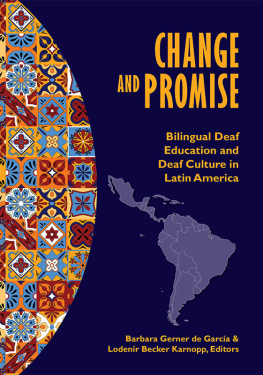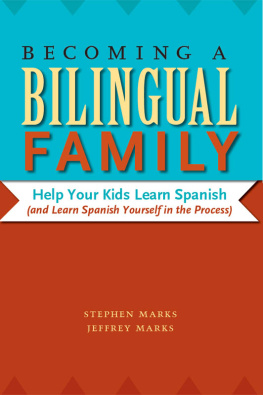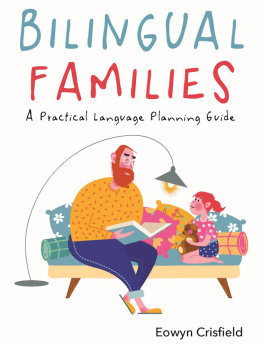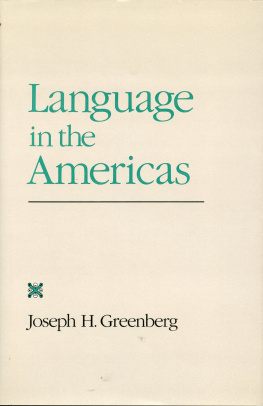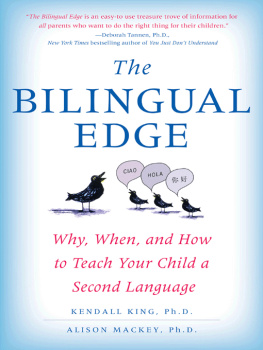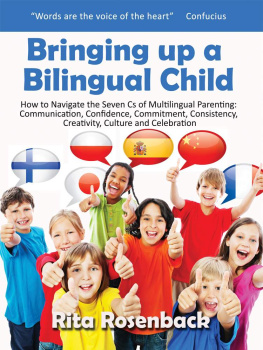Barbara R Greenberg - Teenage as a Second Language: A Parents Guide to Becoming Bilingual
Here you can read online Barbara R Greenberg - Teenage as a Second Language: A Parents Guide to Becoming Bilingual full text of the book (entire story) in english for free. Download pdf and epub, get meaning, cover and reviews about this ebook. year: 2010, publisher: Adams Media, genre: Home and family. Description of the work, (preface) as well as reviews are available. Best literature library LitArk.com created for fans of good reading and offers a wide selection of genres:
Romance novel
Science fiction
Adventure
Detective
Science
History
Home and family
Prose
Art
Politics
Computer
Non-fiction
Religion
Business
Children
Humor
Choose a favorite category and find really read worthwhile books. Enjoy immersion in the world of imagination, feel the emotions of the characters or learn something new for yourself, make an fascinating discovery.
- Book:Teenage as a Second Language: A Parents Guide to Becoming Bilingual
- Author:
- Publisher:Adams Media
- Genre:
- Year:2010
- Rating:5 / 5
- Favourites:Add to favourites
- Your mark:
- 100
- 1
- 2
- 3
- 4
- 5
Teenage as a Second Language: A Parents Guide to Becoming Bilingual: summary, description and annotation
We offer to read an annotation, description, summary or preface (depends on what the author of the book "Teenage as a Second Language: A Parents Guide to Becoming Bilingual" wrote himself). If you haven't found the necessary information about the book — write in the comments, we will try to find it.
Teenage as a Second Language: A Parents Guide to Becoming Bilingual — read online for free the complete book (whole text) full work
Below is the text of the book, divided by pages. System saving the place of the last page read, allows you to conveniently read the book "Teenage as a Second Language: A Parents Guide to Becoming Bilingual" online for free, without having to search again every time where you left off. Put a bookmark, and you can go to the page where you finished reading at any time.
Font size:
Interval:
Bookmark:
Teenage
as aSecond
Language
A Parents Guide to
Becoming Bilingual
Barbara R. Greenberg, PhD
and Jennifer A. Powell-Lunder, PsyD

Copyright 2010 Barbara R. Greenberg and Jennifer A. Powell-Lunder
All rights reserved.
This book, or parts thereof, may not be reproduced in any
form without permission from the publisher; exceptions are
made for brief excerpts used in published reviews.
Published by
Adams Media, an imprint of Simon & Schuster, Inc.
57 Littlefield Street, Avon, MA 02322. U.S.A.
www.adamsmedia.com
ISBN 10: 1-4405-0464-4
ISBN 13: 978-1-4405-0464-8
eISBN 10: 1-4405-0916-6
eISBN 13: 978-1-4405-0916-2
Printed in the United States of America.
10 9 8 7 6 5 4 3 2 1
Library of Congress Cataloging-in-Publication Data
Greenberg, Barbara R.
Teenage as a second language / Barbara R. Greenberg & Jennifer A. Powell-Lunder.
p. cm.
Includes index.
ISBN-13: 978-1-4405-0464-8
ISBN-13: 978-1-4405-0916-2 (ebk.)
ISBN-10: 1-4405-0464-4
ISBN-10: 1-4405-0916-6 (ebk.)
1. Teenagers Language. 2. Body language. 3. Communication. I. Powell-Lunder, Jennifer
A. II. Title.
P120.Y68G74 2010
408.35 dc22
2010027247
This publication is designed to provide accurate and authoritative information with regard to the subject matter covered. It is sold with the understanding that the publisher is not engaged in rendering legal, accounting, or other professional advice. If legal advice or other expert assistance is required, the services of a competent professional person should be sought.
From a Declaration of Principles jointly adopted by a Committee of the American Bar
Association and a Committee of Publishers and Associations
This book is available at quantity discounts for bulk purchases.
For information, please call 1-800-289-0963.
Dedication
This book is dedicated to our families who have stood behind us throughout this process.
It is equally dedicated to the hundreds of teens who let us into their lives and taught us to understand what they were saying.
Acknowledgments
This book started as a discussion at the kitchen table between two good friends who happen to be psychologists. We began this journey with nothing but the knowledge that we needed to write this book. Starting with only a title, we watched as this project truly took on a life of its own. We thank the following people who offered direction, inspiration, and support. Without them we would still be sitting at the kitchen table.
To Jeanne Fredericks our amazing agent and guide.
To Paula Munier at Adams Media for her enthusiasm and commitment.
To Katie Corcoran Lytle at Adams Media because no question was too small or unimportant.
We are indebted to the following people: Lisa Green, John Silber-sack, Laura Nolan, Janet Segal, Bill Lunder, Sydney Lunder, Barrett Lunder, Sherry Powell, Ronald Powell, Jonathan Powell, Bob Lunder, Angie Lunder, Linda Sussman, Tracy Schofield, Amanda Harvey, Ted Jonathan, Douglas Anderson, Derek Anderson, Pearl Green, Jayne Stein, Sharon Green, Mitch Greenberg, and Amy Foster.
Contents
CHAPTER 1
CHAPTER 2
CHAPTER 3
CHAPTER 4
CHAPTER 5
CHAPTER 6
CHAPTER 7
Introduction
Fine. Whatever. Idontcare. These can be the most frustrating words that parents ever hear. What do they even mean? you may be asking yourself. As parents you sometimes misunderstand what your teenagers are really trying to say and often find yourselves unable to respond effectively. Your children are at an age where you are encouraging them to express themselves, but you are unfortunately unable to understand their language. But there is hope. Throughout this book, we will teach you to translate what your teens actually say in English to what they really mean in Teenage. In an honest, clear, and concise manner, we combine our own experience working with parents and teenagers with the most current research on parentteenage communication and explain how to really understand and talk to your teens.
The benefit isnt just a better relationship with your children. Research consistently concludes that both the quantity and quality of the communication between teenagers and parents affects teenage decision-making. It is evident that teens make healthier decisions, cope better with peer pressure, and have higher selfesteem when their parents positively and consistently talk to them about sensitive topics such as safe sex and drug use. In fact, adults who characterized their teenage years as marked by positive communication with their parents report a higher quality of life as adults in comparison to those who were unable to communicate well with their parents as teens.
This quick and easy reference will serve as your guide to understanding your teenagers. Youll learn how to become your teenagers confidante, translate nonverbal communication such as changes in dress or behavior, and know when or if to worry and how to react. Well also help you figure out how to interpret requests for more independence; understand, manage, and prevent the negative effects which can result from keeping secrets and telling lies; and initiate communication regarding sensitive topics. Within each chapter you will find easy-to-read tables and lists providing you with the information and tools you need to talk to your teens. Use them as reference guides to teach and reinforce your Teen communication skills. You will also find Get Them Talking segments, which serve as quick conversation starters, scattered throughout the text. In addition, weve included Teen Speak segments that provide you with commonly misunderstood words, phrases, and nonverbal language to help you proceed on your journey toward fluency.
Its important to keep in mind that, when learning any new language, the first few lessons are usually the most difficult. The more Teenage you learn the more competent you will feel. The bottom line is that when you are able to communicate effectively with your teen-agers, both they and you! will feel better about yourselves, your relationships, and the future. So use this book as your guide and get ready for an immersion course in Teenage.
Good luck!
CHAPTER 1
Getting Started Teenage 101: Understanding the Basics on the Road Toward Fluency
Take a moment to think back to your own adolescence. You may recall carefree days when your only responsibilities included completing your homework on time and perhaps working a part-time job to earn some fun money. Now spend some time talking to your teens. We can assure you that they will use many adjectives to describe their experiences but carefree will not be one of them! Clearly with all of our new technological advances texting, Facebook, iPods, etc. things have gotten a bit more complicated. The point? Each of our experiences is relative.
There is a strong chance (especially if you are reading this book) that your teenagers believe you do not have a clue about how difficult and complicated life is for them. You may actually feel the same way about their perceptions of your life! Believe it or not, some of their belief systems can be attributed to plain old biology. So, keeping this in mind, lets focus quickly on adolescent development before delving into how to understand their language.
What Happened to My Baby?
While there continues to be much debate regarding the age at which adolescence officially ends, most agree that the beginning of adolescence is marked by the start of puberty. Recently called the
Next pageFont size:
Interval:
Bookmark:
Similar books «Teenage as a Second Language: A Parents Guide to Becoming Bilingual»
Look at similar books to Teenage as a Second Language: A Parents Guide to Becoming Bilingual. We have selected literature similar in name and meaning in the hope of providing readers with more options to find new, interesting, not yet read works.
Discussion, reviews of the book Teenage as a Second Language: A Parents Guide to Becoming Bilingual and just readers' own opinions. Leave your comments, write what you think about the work, its meaning or the main characters. Specify what exactly you liked and what you didn't like, and why you think so.



